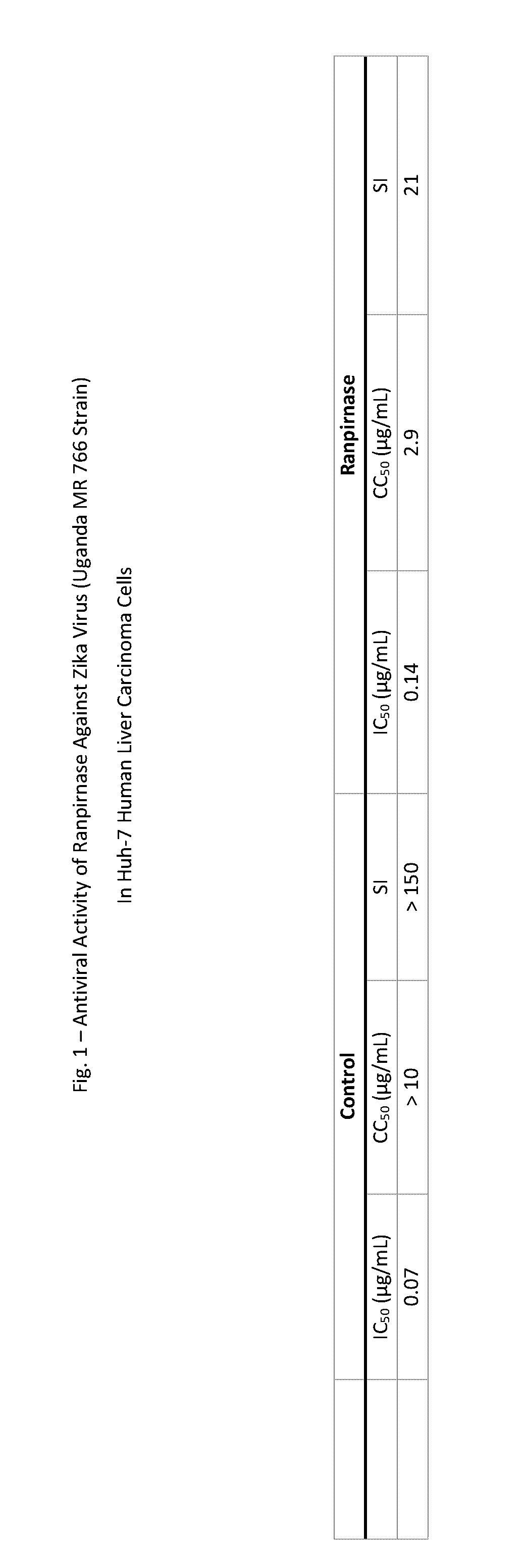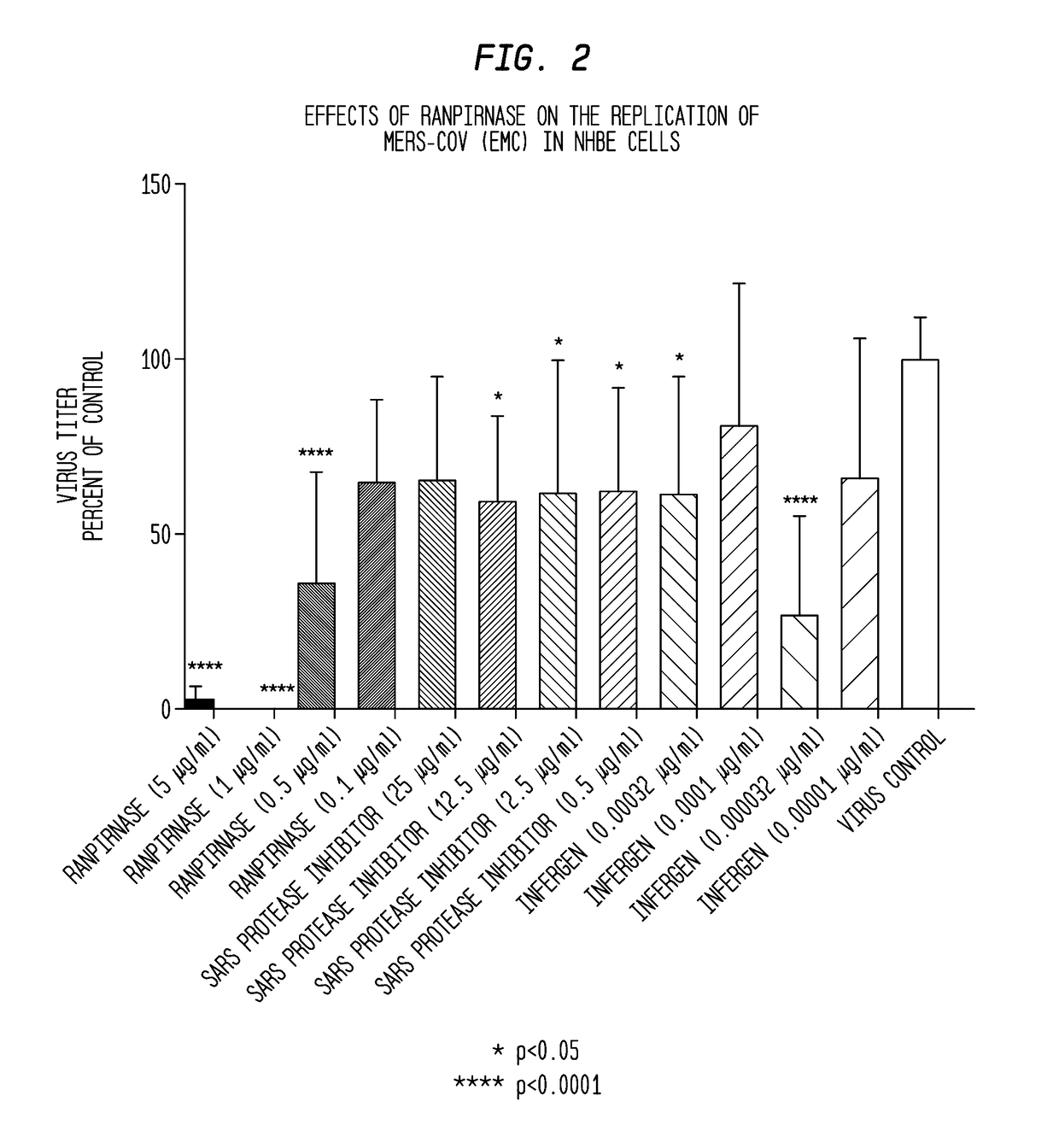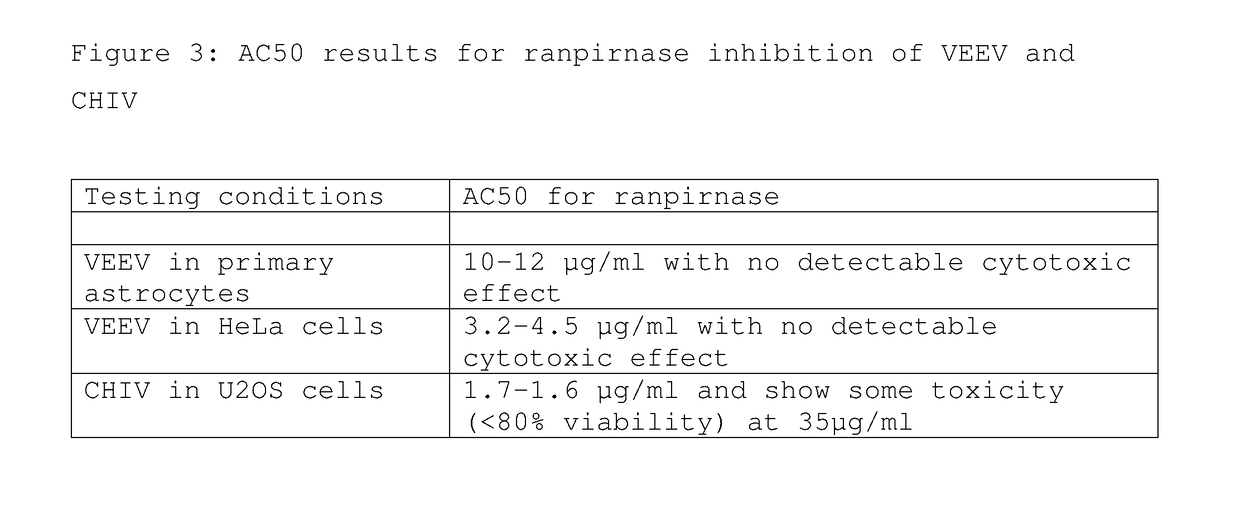Methods of treating zika virus, mers-cov, chikungunya, venezuelan equine encephalitus, and rhinovirus in mammalian patients
a technology of zika virus and rhinovirus, which is applied in the field of zika virus treatment, can solve the problem of virus eventually dying
- Summary
- Abstract
- Description
- Claims
- Application Information
AI Technical Summary
Benefits of technology
Problems solved by technology
Method used
Image
Examples
example 1
Zika Virus in Huh-7 Liver Carcinoma Cells
[0027]The antiviral activity of ranpirnase against Zika virus strain Uganda MR 766 in Huh-7 human liver carcinoma cells was assessed. Interferon (which is known to be active against this Zika virus strain) was run in parallel as a control.
[0028]The ranpirnase and the control were serially diluted to produce eight half-log dilutions in MEM medium. The diluent for ranpirnase was 50 μg / mL gentamicin and serum; the diluent for interferon was 50 μg / mL gentamicin and serum and trypsin. Each dilution was added to 5 wells of a 96-well plate with 80%-100% confluent cells, and three wells of each dilution were then infected. Two wells remained uninfected as toxicity controls.
[0029]The virus was incubated for 4 days at 37° C. and 5% CO2. After cytopathic effect (CPE) was observed microscopically, plates were scored for degree of CPE and then stained with neutral red dye for approximately 2 hours, then supernatant dye was washed from the wells and the in...
example 2
MERS-CoV in NHBE Cells
[0033]In the experiment illustrated in FIG. 2, the anti-viral activity of ranpirnase against MERS-CoV virus was compared to the activities of two known anti-viral agents: SARS protease inhibitor and Infergen. The experiment was carried out using four different concentrations of each agent on normal human bronchial epithelial (NHBE) cells.
[0034]More specifically, the NHBE cells were grown in HEPES Buffered Saline Solution at 37° C. for seven days. The cells were washed and refreshed once daily. Two controls were used: one contained MERS-CoV virus and the other contained uninfected NHBE cells that were treated with the agents under test.
[0035]On the eighth day, the tested concentrations of the three agents under test were introduced into the cells and buffer solution and the virus was introduced at a multiplicity of infection (“MOI”) of 0.01. The virus- and agent-containing samples were then incubated for 72 hours at 37° C. and 5% CO2, with the medium being reple...
example 3
VEEV, and CHIV (In Vitro)
[0039]Methodology
[0040]Several studies were conducted to assess the ability of ranpirnase to inhibit infection of cells by VEEV and CHIV. Ranpirnase solution and powder-derived ranpirnase were tested. The powder-derived ranpirnase was lyophilized ranpirnase provided by Tamir Biotechnology, Inc. Quality control of the assay was conducted using Positive (Neutral) control (n=16) or infected cells+media, uninfected cells (Negative control) (n=16) and dose response for control inhibitors (n=2 or 4). Z′ was calculated for Neutral control and uninfected cells. Data were normalized on the plate bases. Data analysis was done using GeneData software and analysis of dose response curve to determine ED50 of ranpirnase was performed using GeneDataCondoseo software applying Levenberg-Marquardt algorithm (LMA) for curve fitting strategy.
[0041]VEEV in Astrocytes
[0042]To test the effect of ranpirnase on VEEV infection of astrocytes, ranpirnase solution (“RAN”) was tested in ...
PUM
| Property | Measurement | Unit |
|---|---|---|
| cytotoxic concentration | aaaaa | aaaaa |
| concentration | aaaaa | aaaaa |
| concentrations | aaaaa | aaaaa |
Abstract
Description
Claims
Application Information
 Login to View More
Login to View More - R&D
- Intellectual Property
- Life Sciences
- Materials
- Tech Scout
- Unparalleled Data Quality
- Higher Quality Content
- 60% Fewer Hallucinations
Browse by: Latest US Patents, China's latest patents, Technical Efficacy Thesaurus, Application Domain, Technology Topic, Popular Technical Reports.
© 2025 PatSnap. All rights reserved.Legal|Privacy policy|Modern Slavery Act Transparency Statement|Sitemap|About US| Contact US: help@patsnap.com



